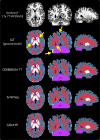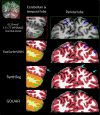GOUHFI: A novel contrast- and resolution-agnostic segmentation tool for ultra-high-field MRI
- PMID: 41158555
- PMCID: PMC12556684
- DOI: 10.1162/IMAG.a.960
GOUHFI: A novel contrast- and resolution-agnostic segmentation tool for ultra-high-field MRI
Abstract
Recently, ultra-high-field MRI (UHF-MRI) has become more available and one of the best tools to study the brain for neuroscientists. One common step in quantitative neuroimaging is to segment the brain into several regions, which has been done using software packages such as FreeSurfer, FastSurferVINN, or SynthSeg. However, the differences between UHF-MRI and 1.5T or 3T images are such that the automatic segmentation techniques optimized at these field strengths usually produce unsatisfactory segmentation results for UHF images. Thus, it has been particularly challenging to perform region-based quantitative analyses as typically done with 1.5-3T data, considerably limiting the potential of UHF-MRI until now. Ultimately, this underscores the crucial need for developing new automatic segmentation techniques designed to handle UHF images. Hence, we propose a novel Deep Learning (DL)-based segmentation technique called GOUHFI: Generalized and Optimized segmentation tool for ultra-high-field images, designed to segment UHF images of various contrasts and resolutions. For training, we used a total of 206 label maps from four datasets acquired at 3T, 7T, and 9.4T. In contrast to most DL strategies, we used a previously proposed domain randomization approach, where synthetic images generated from the 206 label maps were used for training a 3D U-Net. This approach enables the DL model to become contrast agnostic. GOUHFI was tested on seven different datasets and compared with existing techniques such as FastSurferVINN, SynthSeg, and CEREBRUM-7T. GOUHFI was able to segment the six contrasts and seven resolutions tested at 3T, 7T, and 9.4T. Average Dice-Sørensen Similarity Coefficient (DSC) scores of 0.90, 0.90, and 0.93 were computed against the ground truth segmentations at 3T, 7T, and 9.4T, respectively. These results demonstrated GOUHFI's superior performance to competing approaches at each resolution and contrast level tested. Moreover, GOUHFI demonstrated impressive resistance to the typical inhomogeneities observed at UHF-MRI, making it a new powerful segmentation tool allowing the usual quantitative analysis pipelines performed at lower fields to be applied also at UHF. Ultimately, GOUHFI is a promising new segmentation tool, being the first of its kind proposing a contrast- and resolution-agnostic alternative for UHF-MRI without requiring fine tuning or retraining, making it the forthcoming alternative for neuroscientists working with UHF-MRI or even lower field strengths.
Keywords: UHF-MRI; brain segmentation; contrast and resolution agnosticity; deep learning; domain randomization; neuroimaging.
© 2025 The Authors. Published under a Creative Commons Attribution 4.0 International (CC BY 4.0) license.
Conflict of interest statement
The authors do not declare any competing interests.
Figures










References
-
- Billot, B., Greve, D. N., Puonti, O., Thielscher, A., Van Leemput, K., Fischl, B., Dalca, A. V., & Iglesias, J. E. (2023). Synthseg: Segmentation of brain MRI scans of any contrast and resolution without retraining. Medical Image Analysis, 83, 102687. 10.1016/j.media.2022.102687 - DOI - PMC - PubMed
-
- Bonferroni, C. (1936). Teoria statistica delle classi e calcolo delle probabilita. Pubblicazioni del R Istituto Superiore di Scienze Economiche e Commericiali di Firenze, 8, 3–62. 10.4135/9781412961288.n455 - DOI
LinkOut - more resources
Full Text Sources
